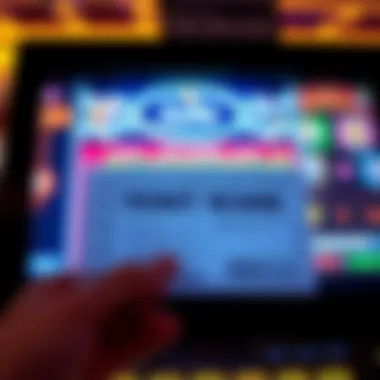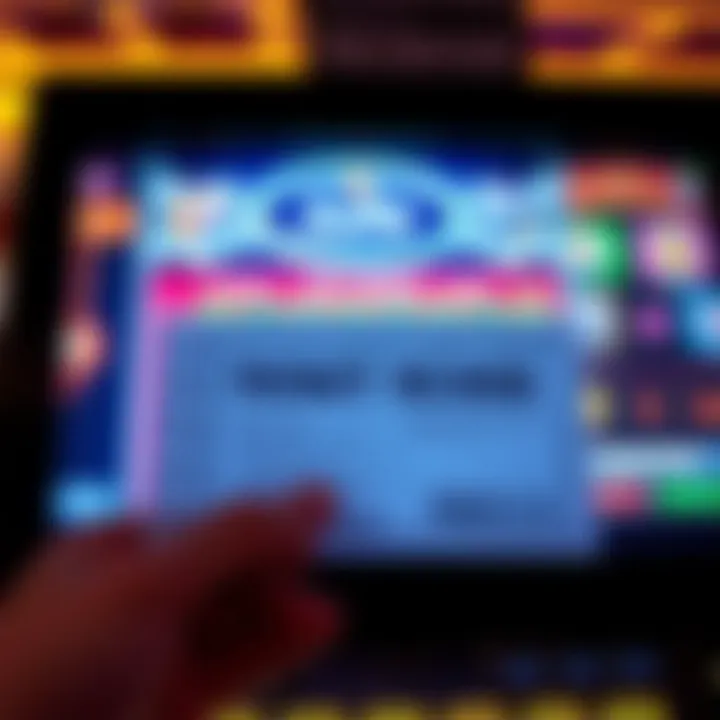Scanning Oregon Lottery Tickets: A Complete Guide


Intro
In the realm of gambling, players are constantly searching for ways to enhance their experience and increase the chances of winning. In Oregon, lottery tickets have become a popular form of entertainment that combines luck with the potential for impressive rewards. Scanning Oregon lottery tickets has emerged as a vital practice, helping participants not only to check their tickets effortlessly but also to understand the intricate workings of lottery technology.
As we delve into the sensations and strategies surrounding this process, we’ll discover how players can harness technology to not only make informed decisions but also engage more deeply with the games they love. This guide will explore the scanning technology, its significance, and the benefits that come with it. Additionally, we will address common issues players face and highlight practical tips that can streamline the experience.
Understanding the ins and outs of scanning Oregon lottery tickets opens up a wealth of knowledge for both casual punters and seasoned enthusiasts. By fusing technology with tradition, players can enjoy a richer and more rewarding interaction with lottery gamin.
"In today’s digital age, understanding technology is key to thriving in the lottery landscape."
This guide serves as a comprehensive resource, examining various aspects of the scanning process. Let’s jump right in to explore the scalability of technology and how it shapes the future of lottery engagement.
Understanding Oregon Lottery Tickets
Understanding Oregon lottery tickets is a cornerstone in grasping how this popular pastime functions in the state. With various types of tickets and validation methods, it’s essential for participants to know the ins and outs to enhance their experience. Knowledge of the specific elements not only simplifies the process of participating but also ensures that players maximize their winnings and enjoy the game to the fullest.
Types of Lottery Tickets
Lottery tickets in Oregon come with diverse options, allowing players to choose what best fits their style and strategy.
Instant Win Scratcher Tickets
Instant win scratcher tickets are often favored for their ease and immediacy. Players simply scratch off the covering to reveal if they’ve won. The key characteristic of scratcher tickets is that they provide instant gratification, which appeals to those who prefer not to wait for a draw.
One unique feature is that these tickets often come with various themes and prize levels, keeping the experience fresh and exciting. However, while they can deliver quick wins, their disadvantage lies in inherently lower jackpot amounts compared to draw game tickets. For many, though, the thrill lies in scratching off the ticket, which can be just as exciting as winning a larger prize.
Draw Game Tickets
Draw game tickets represent a different dimension of lottery play. Here, participants choose numbers or allow the system to generate them randomly. The core appeal here is the possibility of large jackpots, especially for games like Powerball or Mega Millions. Players engage in these draw games with the hope of hitting the big time.
These tickets require a bit more investment in terms of time since players await the drawing for the results. The excitement peaks during the draw, and for many, the wait is part of the thrill. However, the downside can be the lower odds of winning when compared to instant wins, making them a higher stakes gamble.
Powerball and Mega Millions Commencement
The games Powerball and Mega Millions are particularly iconic within the realm of lotteries. The commencement of these games denotes a national attention that elevates the excitement. Key characteristics include massive jackpots and multiple states participating, which leads to ever-increasing prize amounts, quite appealing to many players.
The unique feature of these lotteries is that they operate on a scale that can change lives with a single ticket. However, with such high stakes comes a long odds ratio, often discouraging for some players. Nonetheless, the allure of a life-altering win keeps players coming back for chances in these big draws.
Ticket Validation Mechanism
Each ticket requires a robust validation mechanism to ensure the integrity of the lottery. Understanding how tickets are validated can empower players to claim their winnings swiftly.
Barcode Technology
Barcode technology stands as a fundamental aspect of ticket validation. Each ticket contains a unique barcode that is scanned at various check points. This technology is beneficial because it allows for quick and accurate verification of a ticket’s status. The immediate scan informs the user of their prize status, helping to cut down on human error in claiming cash. However, one disadvantage would be if a ticket is damaged, which can lead to scanning issues or even total invalidation.
Digital Security Features
Digital security features contribute significantly to the trustworthiness of lottery tickets. Embedded within the tickets are security elements that prevent counterfeiting and protect against fraud. These can include holograms, unique serial numbers, and watermarking. Notably, they ensure that the tickets remain credible and that winnings can be claimed without dispute. However, the complexity of these features can sometimes create confusion among players regarding how to recognize genuine tickets versus potential fakes.
Tamper-Proofing Methods
Tamper-proofing methods are vital in maintaining the integrity of lottery tickets. This involves design choices that make it unwieldy to alter or replicate a ticket without an obvious sign of intrusion. The benefit of these methods is that they safeguard against potential fraud, assuring players that their tickets are legitimate. On the flip side, should players inadvertently damage a ticket in any way, they can find themselves unable to claim their rightful winnings owing to the stringent validation processes.
The Importance of Scanning
Scanning lottery tickets is not just about checking whether you've hit the jackpot or not. The importance of scanning lies in its ability to enhance accuracy, provide instant results, and ultimately improve the overall player experience. By integrating this technology into the lottery system, players can make educated decisions, save time, and engage more effectively with the game. As technology continues to evolve, the way we interact with lottery tickets is being revolutionized.
Accuracy in Prize Claiming
Minimizing Human Error
When it comes to lotteries, precision is everything. Minimizing human error is a critical aspect of this process. Traditional methods of checking tickets often rely on players’ familiarity with the winning numbers or the manual process of redeeming tickets, which can lead to mistakes. Scanning rectifies this by providing a quick and reliable means to validate tickets. The key characteristic here is the automation of the verification process. This shifts the responsibility from subjective human judgment to an objective technological system.
One key feature is the integration of optical character recognition (OCR) which scans and reads the data quickly. This not only saves time but also ensures a higher level of accuracy. As a result, players are less likely to overlook minor details, giving them peace of mind when claiming their prizes. However, relying solely on technology can sometimes create issues if systems fail, highlighting the need for a balance between human oversight and technological assistance.
Streamlining the Claim Process
Streamlining the claim process is another vital component of scanning. When players know the ticket scanning process is reliable, they can expect quicker outcomes. Instead of having to wait in line for manual ticket validation, scanning allows for immediate feedback. This efficiency can be a game changer, especially during busy lottery draw nights.


The unique aspect of this efficiency is the use of mobile applications that instantly relay information about winning tickets. As a result, players find it advantageous to use the technology not only for claiming prizes but also for monitoring their ticket status at their convenience. However, it's worth noting that while most smartphones are equipped to scan, not every user can navigate the tech seamlessly, which might still cause delays in some situations.
Real-Time Results
Instant Notifications
Instant notifications are a game-changer for lottery players who crave immediate gratification once the draw happens. This technology keeps players in the loop, providing real-time updates about their ticket status. The key benefit here is the immediacy of information. Players no longer have to wait for the evening news to learn whether they've won. Instead, they can have the results sent directly to their devices.
An interesting feature of instant notifications is the ability to customize alerts based on player preferences—perhaps a player only wants to be notified when they win over a certain amount. While this is hugely beneficial, it does depend upon a reliable internet connection and the functionality of the mobile app—which can sometimes falter in less connected areas.
Mobile Application Integration
Now, mobile application integration is another significant factor in the real-time results discussion. More than just a scanning tool, these applications often offer various features to enhance the user experience, such as payout calculators, historical data, and even social sharing options. This interconnectedness means that players have access to a comprehensive suite of tools right at their fingertips.
The important part about this integration is its impact on the overall claim process. By tying ticket scanning to mobile applications, players streamline many steps into one cohesive system. However, one downside might be the learning curve associated with these features—some players may not be tech-savvy enough to navigate all the options effectively, which could lead to frustration.
Enhanced User Experience
User-Friendly Interfaces
User-friendly interfaces are the backbone of any successful ticket scanning application. A clean, simple design helps enhance the lottery experience, whether someone is an occasional player or a regular enthusiast. The key characteristic of these interfaces lies in their intuitive navigation. Players are more likely to engage with an app that feels accessible and easy to use.
In essence, user-friendly designs keep players focused on what really matters—checking their numbers and enjoying the experience. However, while aesthetic simplicity is advantageous, achieving a balance of functionality and ease of use requires constant attention and updates to ensure satisfaction from all user demographics.
Accessibility Features
Accessibility features need special mention in this context, as they serve to make lottery experiences available to everyone, regardless of their abilities. This includes options for larger text, voice commands for visually impaired users, and a straightforward layout for those who may struggle with more complex applications. Enhancing accessibility not only boosts user engagement but also ensures that more people can take part in the lottery efficiently.
However, while these features represent a commendable approach to inclusivity, not every application has implemented robust accessibility options. Therefore, it remains essential for players to evaluate which apps provide the best accessibility support before making their choices.
The integration of scanning technology into Oregon Lottery tickets symbolizes a step into the future, facilitating a seamless transition from traditional ticket checking to an immediate validation experience.
Tools for Scanning Oregon Lottery Tickets
When it comes to grabbing those elusive lottery winnings, having the right tools for scanning Oregon lottery tickets can make a world of difference. These tools not only enhance your ability to claim your prize but also streamline the overall experience for players of all stripes. The technological advancements in this area mean that whether you're a regular player or an occasional hopeful, there are effective ways to use scanning tools to your advantage.
Mobile Applications
Mobile applications have transformed how players interact with the lottery. Gone are the days when you needed to head to a physical location just to see if your ticket is a winner. Now, your smartphone can do all the heavy lifting.
Official Oregon Lottery App
The Official Oregon Lottery App is the gold standard among lottery apps. It allows players to scan their tickets effortlessly, providing real-time information about prizes. One key characteristic of this app is its reliability, designed specifically for Oregon lottery tickets.
The app boasts a unique feature enabling users to check ticket validity instantly, which will definitely save time for the players. This makes it a popular choice because players can make informed decisions without waiting for a clerk to verify their tickets. One drawback, though, might be that the app requires a stable internet connection to function, which can be a hassle in areas with spotty service.
Third-Party Scanning Apps
Moving beyond the official options, third-party scanning apps have also gained traction in the market. These apps can offer features that appeal to a wider audience. The key characteristic is often the variety of functionalities available; some might include social sharing options or personalized notifications.
One of the standout unique features of many third-party apps is their ability to integrate with other lottery games and platforms, providing players with a unified experience. However, users should tread carefully, as not all third-party apps may be as accurate or trustworthy as the official offerings. There can be inconsistencies in scanning results or privacy concerns regarding personal data.
Handheld Scanners
While mobile applications make scanning tickets a breeze, professional handheld scanners are worth considering, especially for those involved in frequent betting or gaming.
Advantages of Professional Scanners
Professional handheld scanners are designed to provide rapid and accurate ticket verification. The main advantage of using these devices is their robustness. Unlike mobile apps that can be outdated or malfunction, handheld scanners often have a higher accuracy rate and can scan multiple tickets in quick succession. This makes them beneficial for serious players and those involved in participating in larger events.
One downside, however, is that they can be costlier than downloading a mobile app. For casual players, this might seem like overkill.
Comparison of Models
When considering professional scanners, there are various models available on the market, and understanding the differences can help you make a more informed decision. Each model carries its own set of features, ranging from scanning speed to connectivity options. The key characteristic here is not just the price but rather how well each model suits the user's specific needs.
For instance, some models are robust and rugged for fieldwork, while others might be more compact for home use. The unique features might include cloud connectivity or touchscreen interfaces for ease of use. On the flip side, some of the high-end models may come with a hefty price tag, which would discourage the average player from investing too much into ticket scanning.
In summary, whether opting for mobile apps or professional scanners, the tools you choose can greatly impact your overall lottery experience. The best choice will depend on your specific needs, frequency of play, and budget.
Challenges in Scanning


Navigating the world of lottery ticket scanning brings its own set of challenges. While scanning technology aims to provide convenience and efficiency, players often encounter hurdles that can complicate their experience. Understanding these challenges is essential for enhancing the overall lottery experience, enabling players to adopt effective strategies for seamless ticket validation.
Common Technical Issues
This section delves into the technical challenges players frequently face when scanning their lottery tickets. Addressing these issues is crucial for maximizing the functionality of scanning.
Poor Connectivity
Poor connectivity stands out as a significant hurdle, particularly when users attempt to scan their tickets on the go. When you find yourself in a bustling environment, like a crowded bus or busy street, poor connectivity can stall the scanning process, leading to frustration. If the internet connection is weak, it can result in delays or prevent the app from functioning properly. This characteristic emphasizes the need for a reliable internet connection for successful ticket scanning, making it an important aspect for the authenticity of the lottery experience.
The unique feature of poor connectivity is how it can affect the user’s ability to receive real-time updates on their scanning results. Without a stable connection, players risk missing out on prompt notifications about their winnings, which detracts from the thrill of participation. This situation epitomizes a disadvantage in relying on technology for instant validation.
App Malfunctions
App malfunctions pose another reliable hiccup in the scanning process. Instances where the scanning app unexpectedly crashes or fails to read the ticket correctly can spell disaster for eager players. Such malfunctions can stem from software bugs or compatibility issues with certain devices. As we dive into this, it becomes apparent that app stability is crucial for maintaining players’ trust in the scanning process.
The key characteristic of app malfunctions often lies in the inconsistency of performance across devices. While an app may run smoothly on one smartphone, it might have difficulties on another due to differing operating systems or memory capacities. This can create a frustrating experience for users who are relying on technology to enhance their lottery involvement. When these issues arise, players are left feeling shortchanged, as their attempts to validate a ticket are thwarted unexpectedly.
User Errors
Another layer of complexity in the ticket scanning landscape is user errors. Understanding how these errors manifest and how they can be mitigated can greatly improve the accuracy of ticket validation.
Incorrect Scanning Technique
The incorrect scanning technique is frequently responsible for misreading tickets, leading to unintended outcomes. Many players aren’t aware of how to position a ticket correctly or hold their phone at the right angle for optimal scanning. This breeds errors that could have been easily avoided with proper guidance. What stands out about this issue is its preventability through user education and clearer instructions.
The unique aspect of this error is how it underscores the importance of user engagement with the scanning technology. Players benefit from education regarding the scanning process, which can enhance their chances of success. Those who take the time to familiarize themselves with the technology can significantly reduce the rate of user errors, ultimately improving their overall lottery experience.
Understanding Feedback Notifications
Understanding feedback notifications is paramount to effectively navigating the scanning process. These notifications often guide players on whether their ticket has been successfully scanned or if there was an issue that needs addressing. However, many users overlook this crucial feedback, leading to a lack of awareness of what is going wrong.
The key characteristic of feedback notifications is that they serve as an immediate source of information for users. They provide insight into potential errors, ultimately enhancing the user's ability to react appropriately and rectify issues on-the-fly. Not understanding these notifications can lead to repeated mistakes, which frustrate players and hinder a smooth experience. When players prioritize grasping the feedback, they empower themselves to engage more effectively with the scanning technology.
Future of Lottery Ticket Scanning
As technology keeps evolving like a tidal wave, the future of lottery ticket scanning presents both exciting opportunities and notable challenges. Lottery operators and players alike must recognize the importance of staying ahead of the curve. The integration of new technologies not only enhances the overall user experience but also addresses crucial aspects like security, efficiency, and regulation compliance. Understanding these trends will give players a hand up when navigating the often-complex gambling world.
Emerging Technologies
Blockchain in Lottery Verification
Blockchain technology, often linked to cryptocurrencies, carries potential for lottery verification systems. This decentralized digital ledger ensures transparent transaction records that can’t be tampered with easily, playing a key role in maintaining trust among players. Essentially, it allows all transactions to be traced from ticket purchasing to prize claiming, which adds a layer of security not easily achievable otherwise.
The most appealing characteristic of blockchain is its immutability. Once a piece of data is recorded, it’s like trying to unring a bell; almost impossible to alter without detection. This aspect of blockchain makes it a strong candidate for lottery systems that need to stave off fraud. However, the technology is still evolving. The complexity, costs, and the need for widespread adoption pose challenges.
- Advantages:
- Disadvantages:
- Increased transparency in transactions.
- Reduced incidents of fraud.
- Still in early stages of development; not widely adopted.
- Potential for higher operational costs due to the technology’s complexity.
AI-Powered Validation Systems
Artificial Intelligence is carving a niche in lottery ticket scanning as well. These systems can quickly analyze ticket data, providing instant feedback on validity and eligibility for prizes. One notable property of AI-powered systems is their machine learning capability, which means they can get smarter over time. They become progressively better at recognizing patterns and improving accuracy in prize validation.
The benefit here is substantial. With AI, the claim process can be expedited, reducing wait times for players. On the flip side, it’s worth mentioning that excessive reliance on such technology might raise questions around human oversight and accountability.
- Advantages:
- Disadvantages:
- Fast and efficient processing of claims.
- Continuous improvement through learning algorithms.
- Requires robust infrastructure and investment.
- Risk of over-reliance on algorithms without human checks.
Adoption Trends
Market Growth Projections
As the tide of technology keeps rising, market growth projections for lottery ticket scanning indicate a significant leap. With increasing digitization and smartphone usage, the demand for efficient, reliable scanning solutions is expected to grow. Analysts suggest that as ticket sales shift toward digital platforms, the scanning technologies will evolve to meet changing consumer needs.
Notably, the growth in mobile device ownership is a game changer. More people can now access lottery services directly from their phones, making scanning apps essential to the gambling experience. What makes this trend beneficial is the potential for greater market reach.


- Advantages:
- Disadvantages:
- Opens doors for innovative solutions in ticket sales.
- Potential for higher revenue streams
- Intense competition as more companies enter the market.
- The risk of cybersecurity threats can’t be ignored.
Influence on Gambling Behavior
Emerging technologies are also modifying how players engage in lotteries. AI and blockchain affect not just the way tickets are scanned but can also transform the gambler's mindset. The ease of validating a ticket might encourage more frequent participation. One significant characteristic here is the shift towards more data-driven behavior among players, who may become more analytical and pragmatic. They are likely to make informed decisions based on past data and trends.
This shift can be seen as beneficial since it promotes responsible gambling. However, one must also consider that with easy ticket claims, users may become more reckless, chasing losses due to oversimplified methods of validation.
- Advantages:
- Disadvantages:
- Encourages responsible gambling practices with data insights.
- Fosters a more engaged player base.
- The fine line between responsible and reckless play narrows.
- Emotional factors may still override analytical tendencies in high-stake scenarios.
In summary, the future of lottery ticket scanning brims with potential shifts aimed at enhancing the player experience. With emerging technologies like blockchain and AI at the forefront, and adoption trends indicating growth, it's an exhilarating time to be part of the lottery ecosystem. Players in Oregon and beyond should keep an eye on these trends as they unfold, as they’re bound to reshape the landscape.
Legal and Ethical Considerations
The legal and ethical dimensions surrounding lottery ticket scanning in Oregon play a crucial role in ensuring that the integrity of the lottery system is maintained. As technology advances, so too do the responsibilities that come with it. Players must be informed not only about how to accurately scan their tickets, but also about the regulations that govern their actions. This understanding helps to legitimize the excitement and opportunity that accompanies lottery participation while safeguarding against fraudulent behavior.
Regulatory Framework in Oregon
Licensing Authorities
Oregon has a well-defined structure for licensing authorities that oversee lottery operations in the state. The Oregon Lottery Commission is the primary body responsible for ensuring that all lottery activities comply with state laws. This involves issuing licenses to retailers and monitoring their adherence to regulations. The commission's oversight is crucial in maintaining public trust by ensuring fairness in lottery operations.
The key characteristic of the Oregon Lottery Commission lies in its transparency. Public meetings and reports are a regular feature, delivering confidence to players that gaming practices are above board. A major advantage of this structure is the reduction of potential scams and unethical practices that could arise without such oversight. However, one downside may be the potential bureaucracy that could slow down innovative approaches in the industry.
Compliance Standards
Compliance standards serve as the backbone of efficient lottery ticket scanning in Oregon. These standards dictate how lotteries can operate, ensuring they follow proper protocols for ticket sales and operations. It helps in structuring how personal data is handled and how disputes over winning tickets are resolved.
The benefit of stringent compliance standards is that they reassure players that their information is safe and that the lottery process is fair. The focus on accountability means that any mismanagement or impropriety is more likely to be caught. However, a unique feature of these compliance standards also includes the ongoing requirement to adapt to evolving technologies, which could lead to higher operational costs and complexities.
Privacy Concerns
As with any system handling personal and financial information, privacy concerns are paramount in Oregon’s lottery ticket scanning process. Players need to know that their data is not just safe but also used ethically. These concerns often revolve around how data is collected, stored, and shared with third parties.
Data Protection Measures
Oregon has implemented robust data protection measures designed to safeguard sensitive information obtained during the ticket scanning process. This includes encryption protocols and secure servers that store personal data. The aim is to prevent unauthorized access and data breaches that could expose individuals to risks such as identity theft.
These measures are beneficial as they provide a clear framework to protect players, making them feel secure about sharing their personal information. However, one downside is that the complexity of these systems can sometimes lead to misunderstandings about user rights concerning their own data.
User Consent Protocols
User consent protocols are designed to ensure that players clearly understand how their data will be used before they engage in any lottery activities. This includes agreeing to data collection for scanning purposes as well as for promotional activities. By making consent a priority, the lottery aims to create a relationship built on respect for player autonomy.
The distinctive aspect of these protocols is that they empower players, making them more aware of their rights and choices regarding data usage. It’s a beneficial structure as it reinforces trust between players and the lottery system. However, there may be drawbacks, such as some players feeling overwhelmed by the volume of information presented, leading to confusion or reluctance to participate.
"Understanding these legal frameworks not only benefits players but enhances the overall integrity of the lottery system itself."
In summary, grappling with the legal and ethical aspects of lottery ticket scanning is essential for maintaining fairness and transparency. Adherence to regulatory standards, along with a firm commitment to data protection and user consent, cultivates a trustworthy environment for both casual and serious players alike.
Ending
In wrapping up the discussion on scanning Oregon lottery tickets, it's vital to underscore the importance of this topic. The scanning of lottery tickets is not merely a technological advancement; it represents a fundamental shift in how players interact with the lottery system. As we dissected throughout, ticket scanning encompasses various dimensions that enhance security, streamline the claiming process, and elevate the overall user experience. It’s about improving the journey from purchase to prize collection, ensuring that players feel confident and supported at every step.
Recapping the Benefits of Scanning
- Accuracy in Prize Claiming: Scanning technology minimizes human error. Instead of relying on manual checks, which can be fraught with mistakes, digital scanning provides an instant validation of winning tickets. This ensures players receive their due winnings without unnecessary hassle.
- Real-Time Results: Being able to scan tickets not only accelerates the claiming of prizes but also delivers immediate feedback. No more waiting in line or second-guessing whether a ticket is a winner. Players can quickly verify their results, making the experience much more satisfying.
- Enhanced User Experience: A significant benefit of scanning is its contribution to a more user-friendly environment. The incorporation of mobile apps and handheld devices provides users with the tools they need to participate effectively, regardless of technological proficiency. Accessibility features cater to a wider demographic, ensuring that anyone can engage with the lottery system.
In summary, the transition towards scanning has a multitude of benefits; it not only supports accurate financial transactions but also enriches the emotional engagement of players with the game.
Final Thoughts on Enhanced Lottery Experience
Overall, the integration of scanning technology into the Oregon lottery system heralds a new era of player interaction. As we look ahead, several trends emerge, ranging from the potential of AI-enhanced validation systems to the broader implications of digital transformations in gambling. Such advancements will undoubtedly reshape users' experiences, making them feel more in control and secure.
Moreover, as we observe market growth projections, it’s clear: scanning technology could change the gambling landscape. The intersection of user convenience and security measures may well redefine what it means to play the lottery moving forward. Staying informed and adapting to these changes will be vital for all stakeholders in the lottery ecosystem.
"With the rapid pace of technological change, the way we play might be different tomorrow, but the thrill of the game will remain the same."
For further insights on lottery regulations and innovations, visit Oregon Lottery or explore additional discussions on platforms like Reddit for community perspectives.















